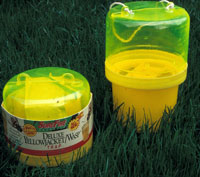Using Traps
We have a selection of yellowjacket traps in our Yardener's Tool Shed; click here
 |
A commercial yellowjacket trap lures the wasps into a chamber from which they can’t escape by means of a chemical attractant, meat, sugar or all three. They die from thirst and exposure. However, traps are not intended to eliminate yellowjackets from your yard. This is not practical. Traps don’t distinguish between yellowjackets that are being pests from those that are simply going about their business as beneficial insects.
Use yellowjacket traps for short-term protection during outdoor activities. Be sure to have enough traps and locate them away from the area you are protecting. Hang traps about 6 feet above the ground and out of direct sun or wind. Set them out about an hour before you bring food outside. After the activity, remove the traps so the yellowjackets are not permanently attracted to the area. If any trapped yellowjackets are still alive at this time, leave the traps out in the sun until the wasps die.
Locating Nests
Yellowjacket nests are difficult to detect early in the season because the population of the colony is relatively small and yellowjacket activity in your yard is unobtrusive. As the summer progresses, you may become aware of the wasps around picnic sites, refuse or trash cans. Observe their flight patterns to locate their nests. Yellowjackets are most easily observed in early morning and late afternoon when the sun is fairly low in the sky.
Protective Clothing
Hire a professional exterminator or a person skilled in handling hornets and bees to deal with yellowjacket nests, especially later in the season when the colony is large. If you chose to do the job yourself, wait until evening when all the yellowjackets have returned to the nest and are inactive.
Wear protective clothing. A beekeeping outfit is best, but heavy coveralls with sealed pant cuffs, long sleeves and heavy duty gloves will work. Wear other clothes beneath this outfit, because wasp stingers can penetrate a single layer of cloth. Wear a broad-brimmed hat with netting tied around it to protect your face and neck.
Destroying Underground Nests
Hot water trick: Locate the nest and block any extra escape holes. Then, pour several gallons of boiling water into the entrance hole. Repeat, if necessary over several evenings for complete kill. The boiling water treatment temporarily sterilizes the soil, so fill the hole with some organic matter after the nest is destroyed to restore its living organisms.
Glass bowl trick: Locate the nest and block any escape holes. Then cover the entrance hole at night with a transparent bowl set firmly into the ground. The yellowjackets, confused by their inability to fly out of the nest at daybreak, will not dig escape holes and will soon starve to death.
Destroying Aboveground Nests
Aboveground nests are more difficult than underground ones. Leave the nest alone until winter when it is empty and harmless. If that is not an option, call a professional to remove it. Removing an aboveground nest of active yellowjackets, especially if it is in structural walls, is not a job for amateurs. If you simply plug the outside entrance hole, the wasps will chew a new hole through the wall and possibly emerge into your living space.
If you must remove an active nest, recruit a helper. Wear protective clothes and wait until evening. Have your helper hold a large stout plastic bag directly beneath the nest. Then cut the nest free as quickly as possible from its supporting branches with a pair of loppers or hand pruners. Seal the bag as soon as the nest drops in, then put the whole thing in the freezer for 24 hours to kill the wasps.

